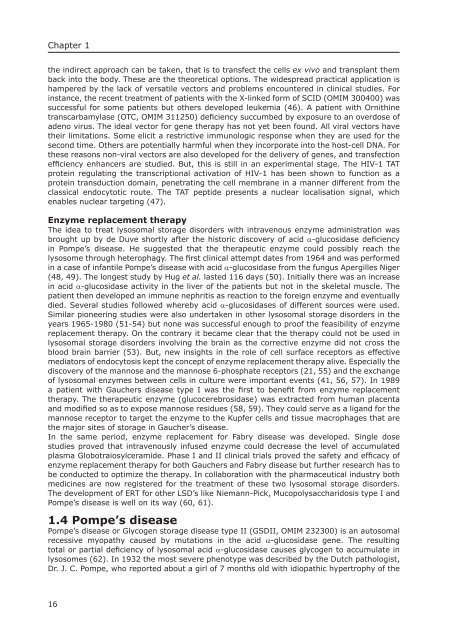Pompe's disease - RePub - Erasmus Universiteit Rotterdam
Pompe's disease - RePub - Erasmus Universiteit Rotterdam
Pompe's disease - RePub - Erasmus Universiteit Rotterdam
Create successful ePaper yourself
Turn your PDF publications into a flip-book with our unique Google optimized e-Paper software.
Chapter 1<br />
the indirect approach can be taken, that is to transfect the cells ex vivo and transplant them<br />
back into the body. These are the theoretical options. The widespread practical application is<br />
hampered by the lack of versatile vectors and problems encountered in clinical studies. For<br />
instance, the recent treatment of patients with the X-linked form of SCID (OMIM 300400) was<br />
successful for some patients but others developed leukemia (46). A patient with Ornithine<br />
transcarbamylase (OTC, OMIM 311250) defi ciency succumbed by exposure to an overdose of<br />
adeno virus. The ideal vector for gene therapy has not yet been found. All viral vectors have<br />
their limitations. Some elicit a restrictive immunologic response when they are used for the<br />
second time. Others are potentially harmful when they incorporate into the host-cell DNA. For<br />
these reasons non-viral vectors are also developed for the delivery of genes, and transfection<br />
effi ciency enhancers are studied. But, this is still in an experimental stage. The HIV-1 TAT<br />
protein regulating the transcriptional activation of HIV-1 has been shown to function as a<br />
protein transduction domain, penetrating the cell membrane in a manner different from the<br />
classical endocytotic route. The TAT peptide presents a nuclear localisation signal, which<br />
enables nuclear targeting (47).<br />
Enzyme replacement therapy<br />
The idea to treat lysosomal storage disorders with intravenous enzyme administration was<br />
brought up by de Duve shortly after the historic discovery of acid α-glucosidase defi ciency<br />
in Pompe’s <strong>disease</strong>. He suggested that the therapeutic enzyme could possibly reach the<br />
lysosome through heterophagy. The fi rst clinical attempt dates from 1964 and was performed<br />
in a case of infantile Pompe’s <strong>disease</strong> with acid α-glucosidase from the fungus Apergilles Niger<br />
(48, 49). The longest study by Hug et al. lasted 116 days (50). Initially there was an increase<br />
in acid α-glucosidase activity in the liver of the patients but not in the skeletal muscle. The<br />
patient then developed an immune nephritis as reaction to the foreign enzyme and eventually<br />
died. Several studies followed whereby acid α-glucosidases of different sources were used.<br />
Similar pioneering studies were also undertaken in other lysosomal storage disorders in the<br />
years 1965-1980 (51-54) but none was successful enough to proof the feasibility of enzyme<br />
replacement therapy. On the contrary it became clear that the therapy could not be used in<br />
lysosomal storage disorders involving the brain as the corrective enzyme did not cross the<br />
blood brain barrier (53). But, new insights in the role of cell surface receptors as effective<br />
mediators of endocytosis kept the concept of enzyme replacement therapy alive. Especially the<br />
discovery of the mannose and the mannose 6-phosphate receptors (21, 55) and the exchange<br />
of lysosomal enzymes between cells in culture were important events (41, 56, 57). In 1989<br />
a patient with Gauchers <strong>disease</strong> type I was the fi rst to benefi t from enzyme replacement<br />
therapy. The therapeutic enzyme (glucocerebrosidase) was extracted from human placenta<br />
and modifi ed so as to expose mannose residues (58, 59). They could serve as a ligand for the<br />
mannose receptor to target the enzyme to the Kupfer cells and tissue macrophages that are<br />
the major sites of storage in Gaucher’s <strong>disease</strong>.<br />
In the same period, enzyme replacement for Fabry <strong>disease</strong> was developed. Single dose<br />
studies proved that intravenously infused enzyme could decrease the level of accumulated<br />
plasma Globotraiosylceramide. Phase I and II clinical trials proved the safety and effi cacy of<br />
enzyme replacement therapy for both Gauchers and Fabry <strong>disease</strong> but further research has to<br />
be conducted to optimize the therapy. In collaboration with the pharmaceutical industry both<br />
medicines are now registered for the treatment of these two lysosomal storage disorders.<br />
The development of ERT for other LSD’s like Niemann-Pick, Mucopolysaccharidosis type I and<br />
Pompe’s <strong>disease</strong> is well on its way (60, 61).<br />
1.4 Pompe’s <strong>disease</strong><br />
Pompe’s <strong>disease</strong> or Glycogen storage <strong>disease</strong> type II (GSDII, OMIM 232300) is an autosomal<br />
recessive myopathy caused by mutations in the acid α-glucosidase gene. The resulting<br />
total or partial defi ciency of lysosomal acid α-glucosidase causes glycogen to accumulate in<br />
lysosomes (62). In 1932 the most severe phenotype was described by the Dutch pathologist,<br />
Dr. J. C. Pompe, who reported about a girl of 7 months old with idiopathic hypertrophy of the<br />
16

















